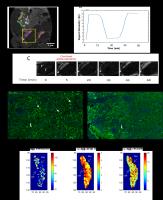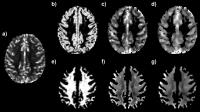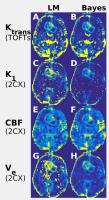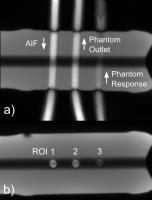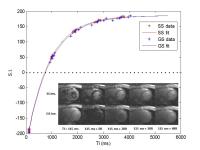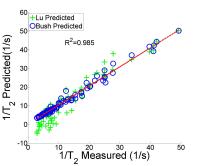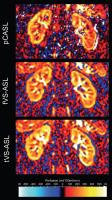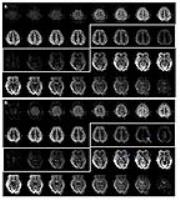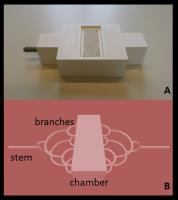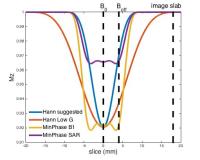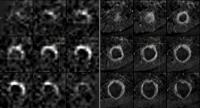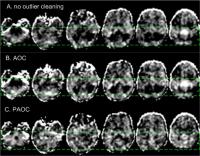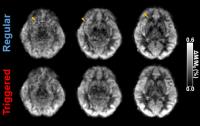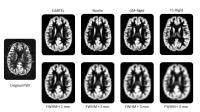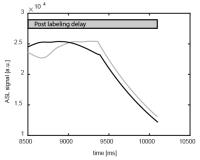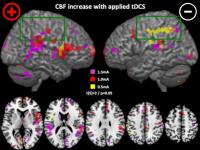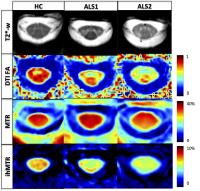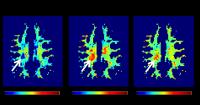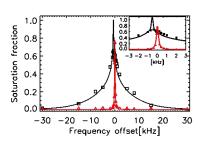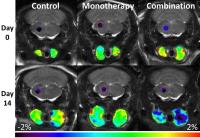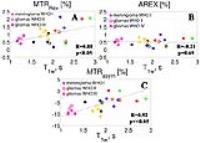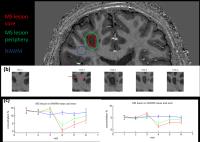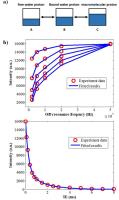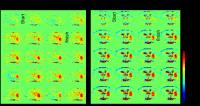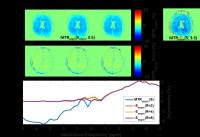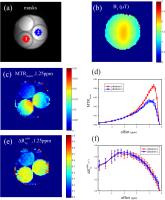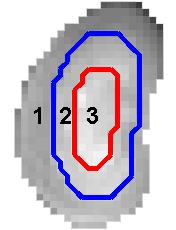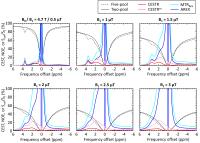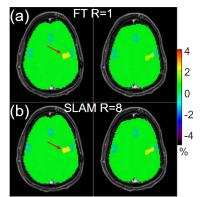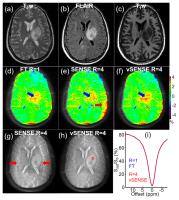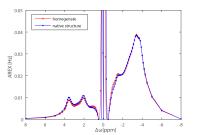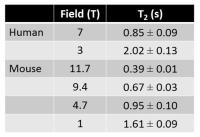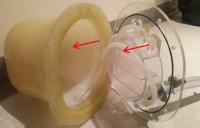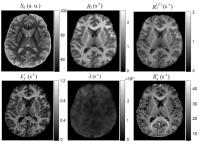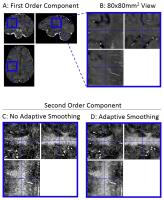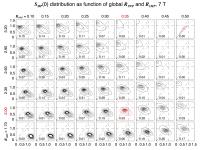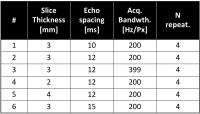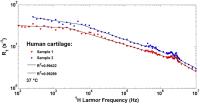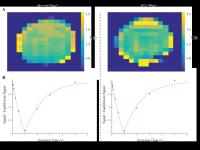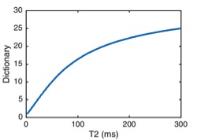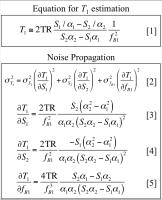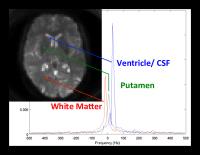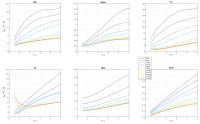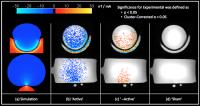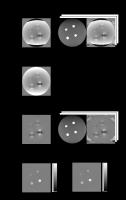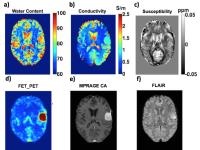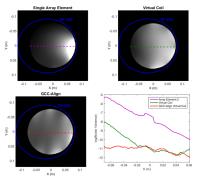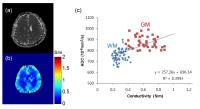 |
1543.
 |
The Role of Finite Difference Schemes in Morphology Enabled
Dipole Inversion (MEDI) for Quantitative Susceptibility Mapping
(QSM)
Youngwook Kee1, Kofi Mawuli Deh1,
Pascal Spincemaille1, and Yi Wang1
1Weill Cornell Medical College, New York, NY,
United States
Since QSM has been recently undergoing clinical trials and
the MEDI toolbox plays an important role for this purpose,
numerical implementation should be consistent in the sense
of continuum limit. In this abstract, we point out a
numerically inconsistent finite difference scheme that has
been used in the MEDI toolbox and show that by replacing it
with a consistent one it drastically improves image quality.
|
|
1544.
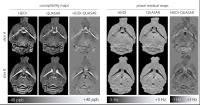 |
QUASAR: In vivo quantification of magnetic susceptibility in
rodents 
Ferdinand Schweser1,2, Paul Polak1,
Nicola Bertolino1, and Robert Zivadinov1,2
1Buffalo Neuroimaging Analysis Center, Department
of Neurology, Jacobs School of Medicine and Biomedical
Sciences, The State University of New York at Buffalo,
Buffalo, NY, United States, 2MRI
Molecular and Translational Research Center, Jacobs School
of Medicine and Biomedical Sciences, The State University of
New York at Buffalo, Buffalo, NY, United States
Despite increasing exploration of quantitative
susceptibility mapping (QSM) in humans and the method's
potential to study tissue iron pre-clinically, only few
studies have yet applied QSM in alive rodents at ultra-high
magnetic field strength. In the present work we hypothesized
that the low quality of pre-clinical QSM compared to human
QSM is due to the combination of a similar level of
non-susceptibility phase contributions with much lower
susceptibility variations. Here, we propose a new type of
QSM algorithm that accounts for non-susceptibility phase
effects and, hence, enables pre-clinical QSM: QUAntitative
Susceptibility And Residual mapping (QUASAR).
|
|
1545.
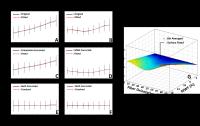 |
Effects of fiber orientation and myelin concentration on R2*
(=1/T2*): a fiber orientation and/or myelin concentration
corrected R2* map 
Jingu Lee1, Woojin Jung1, Yoonho Nam2,
and Jongho Lee1
1Laboratory for Imaging Science and Technology,
Department of Electrical and Computer Engineering, Seoul
National University, Seoul, Korea, Republic of, 2Department
of Radiology, Seoul St. Mary’s Hospital, College of
Medicine, The Catholic University of Korea, Seoul, Korea,
Republic of
In this work, we measured the effect size of both myelin
concentration and fiber orientation in R2*.
Additionally, we generated the myelin concentration and/or
fiber orientation bias free R2* maps which may
have important applications.
|
|
1546.
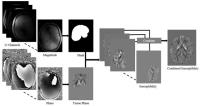 |
Echo time based influences on quantitative susceptibility
mapping
Surabhi Sood1, Javier Urriola1, David
Reutens1, Steffen Bollmann1, Kieran
O'Brien2, Markus Barth1, and Viktor
Vegh1
1Centre for Advanced Imaging, The University of
Queensland, Brisbane, Australia, 2Siemens
Ltd., Brisbane, Australia
Quantitative susceptibility mapping is an important magnetic
resonance imaging tool which can help define brain structure
and composition. Our work aims to explore information
contained in the temporal trend by analysing the mapped
magnetic susceptibility as a function of echo time from
gradient recalled data acquired at 7T. Temporal
susceptibility plots were studied in ten brain regions.
Parameterisation of image voxel susceptibility compartments
has the potential to delineate structural and chemical
changes in tissue and formulate biologically meaningful
measures. This in turn provides a framework for new imaging
biomarker developments in neurodegenerative diseases and
disorders affecting the central nervous system.
|
|
1547.
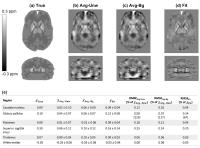 |
Application of Laplacian-based Methods to Multi-echo Phase Data
for Accurate Susceptibility Mapping 
Emma Biondetti1, David L. Thomas2, and
Karin Shmueli1
1Department of Medical Physics and Biomedical
Engineering, University College London, London, United
Kingdom, 2Leonard
Wolfson Experimental Neurology Centre, UCL Institute of
Neurology, University College London, London, United Kingdom
In Susceptibility Mapping (SM) using multi-echo
gradient-echo phase data, unwrapping and/or background-field
removal is often performed using Laplacian-based methods.
However, SM pipelines in the literature have applied these
methods at different stages. Here, using simulated and
acquired images, we compared the performance of three
pipelines that apply Laplacian-based methods at different
stages. We showed that Laplacian-based methods alter the
linearity of the phase over time. We demonstrated that only
a processing pipeline that takes this into account, i.e. by
fitting the multi-echo data over time to correctly estimate
a field map before applying Laplacian-based methods, gives
accurate susceptibility values.
|
|
1548.
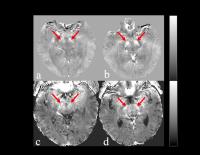 |
Quantitative Susceptibility Mapping of the Substantia Nigra in
Parkinson’s Disease 
Xinxin Zhao1, Hedi An2, Tian Liu3,
Nan Shen2, Binshi Bo4, Zhuwei Zhang4,
Pengfei Weng4, Meining Chen4, Mengchao
Pei4, Yi Wang3,4, Dongya Huang2,
and Jianqi Li4
1Shanghai Key Laboratory of Magnetic Resonance
and Department of Physics, East China Normal University,
Shanghai, China, People's Republic of, 2Dongfang
Hospital Neural Medical Affiliated Tongji University,
Shanghai, China, People's Republic of, 3Department
of Radiology, Weill Medical College of Cornell University,
New York, NY, United States, 4Department
of physics, Shanghai Key Laboratory of Magnetic Resonance
and Department of Physics, East China Normal University,
Shanghai, China, People's Republic of
Quantitative susceptibility mapping (QSM) provides excellent
contrast of iron-rich deep nuclei to quantify iron in the
brains. Clinicians are interested in using QSM to diagnose
PD patients. QSM and R2* values were measured in the whole
substantia nigra in patients with PD and healthy controls.
The significant difference between PD patients and healthy
controls in the substantia nigra was found on QSM but not on
R2* mapping.
|
|
1549.
 |
Are susceptibility-weighted imaging and quantitative
susceptibility mapping suitable to gain additional information
on melanoma metastasis of the brain? 
Sina Straub1, Till Schneider2,3,
Christian H. Ziener3, Heinz-Peter Schlemmer3,
Mark E. Ladd1, Frederik B. Laun1, and
Martin T. Freitag3
1Department of Medical Physics in Radiology,
German Cancer Research Center (DKFZ), Heidelberg, Germany, 2Department
of Neuroradiology, University of Heidelberg, Heidelberg,
Germany, 3Department
of Radiology, German Cancer Research Center (DKFZ),
Heidelberg, Germany
The benefit of susceptibility weighted imaging (SWI) and
quantitative susceptibility mapping (QSM) for the detection
and quantification of bleeding of brain metastases of
malignant melanoma is assessed. QSM shows paramagnetic
values for hemorrhagic metastases (0.355±0.097 ppm) and less
paramagnetic values (0.239±0.123 ppm) for hemorrhagic
metastases that have T1w-native hyperintense signal.
Moreover, our findings suggest that T1w-native hyperintense
melanoma metastases have relatively diamagnetic
susceptibility compared to other structures of the brain.
|
|
1550.
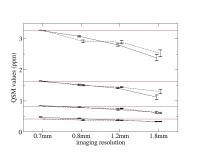 |
Susceptibility underestimation in a high susceptibility phantom:
dependence on imaging resolution, magnitude contrast and sample
orientation 
Dong Zhou1, JingWei Zhang2, Pascal
Spincemaille1, and Yi Wang1,2
1Radiology Department, Weill Cornell Medical
College, New York, NY, United States, 2Biomedical
Engineering, Cornell University, Ithaca, NY, United States
The error in digitizing the dipole convolution1 may
become substantial when there is abrupt susceptibility
change within a voxel. To evaluate this error, we assessed
the accuracy of quantitative susceptibility mapping in a
gadolinium balloon phantom with a range of large
susceptibility values (0.4 – 3.2 ppm) and imaging
resolutions (0.7 – 1.8 mm) at both 1.5T and 3T. Systematic
underestimation of the susceptibility values was observed
with decreasing imaging resolution. Numerical simulations
were performed to match the experimental findings. These
show that the underestimation originates directly from the
changes in the voxel sensitivity function and that the
amount of underestimation is affected not only by imaging
resolution, but also magnitude contrast, the use of k-space
filters in the image reconstruction, and details of the
susceptibility inclusions such as the susceptibility value
and geometry.
|
|
1551.
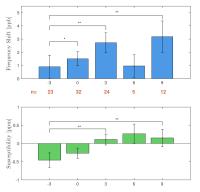 |
The use of quantitative susceptibility imaging for the
evaluation of acute MS lesion formation 
Vanessa Wiggermann1,2, Enedino Hernandez-Torres2,3,
Inga C Ibs4, Stephanie M Schoerner5,
Galina Vorobeychik6, Luanne Metz7,
David KB Li8,9, Anthony Traboulsee9,10,
and Alexander Rauscher2,9,11
1Physics and Astronomy, University of British
Columbia, Vancouver, BC, Canada, 2Pediatrics,
University of British Columbia, Vancouver, BC, Canada, 3UBC
MRI Research Centre, University of British Columbia,
Vancouver, BC, Canada, 4University
of Osnabrueck, Osnabrueck, Germany, 5Technical
University of Dortmund, Dortmund, Germany, 6Fraser
Health MS Clinic, Burnaby, BC, Canada, 7Clinical
Neurosciences, University of Calgary, Calgary, AB, Canada, 8Radiology,
University of British Columbia, Vancouver, BC, Canada, 9Center
for Brain Health, University of British Columbia, Vancouver,
BC, Canada, 10Medicine
(Neurology), University of British Columbia, Vancouver, BC,
Canada, 11Child
and Family Research Institute, University of British
Columbia, Vancouver, BC, Canada
Using magnetic-susceptibility based MR techniques for the
assessment of damage due to multiple sclerosis (MS) has been
controversial, in particular in MS lesions where the
underlying pathological changes are not yet fully
understood. Here, we investigated the changes of the MR
frequency and quantitative susceptibility signal during
acute MS lesion formation. We observed that both metrics
behave similarly, indicating that non-local effects have
little contribution to the QSM signal increase and hence
dipole inversion might not be required to assess damage
during MS lesion formation accurately.
|
|
1552.
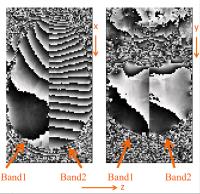 |
Rapid Quantitative Susceptibility Mapping with Simultaneous
Multi-Band Imaging 
Nan-Jie Gong1, Hing-Chiu Chang2,
Hongjiang Wei1, Mark Sundman1,
Nan-kuei Chen1, and Chunlei Liu1
1Brain Imaging and Analysis Center, Duke
University, Durham, NC, United States, 2Diagnostic
Radiology, The University of Hong Kong, Hong Kong, China,
People's Republic of
We demonstrated the feasibility of using the proposed phase
correction method for increasing the accuracy of QSM
reconstruction from multi-band acquisitions. With multi-band
acquisition, we were able to greatly shorten data
acquisition time. It is expected that facilitate this method
would benefit further clinical application of QSM and QSM
based cerebral functional and physiological studies.
|
|
1553.
 |
Visibility improvement of cerebral blood vessels by High
Resolution Quantitative Susceptibility Mapping
Yuya Umemoto1, Tomohiro Ueno1,
Shin-ichi Urayama2, Toshihiko Aso2,
Hidenao Fukuyama2, and Naozo Sugimoto1
1Human Health Sciences, Kyoto University, Kyoto,
Japan, 2Human
Brain Research, Kyoto University, Kyoto, Japan
In Quantitative Susceptibility Mapping, susceptibility
distribution can be obtained by deconvolution of perturbed
fields with dipole fields. In our proposed method, High
Resolution QSM, we employed densely sampled dipole fields to
improve the quality of QSM. To verify the High Resolution
QSM, we performed a human study, and acquired QSM input
phase data of a healthy human subject. We compared MIP of
the High Resolution QSM to that of the tricubically
interpolated conventional QSM. In the High Resolution QSM,
visibility of several cerebral blood vessels is improved.
This means that a susceptibility map with higher spatial
resolution is obtained.
|
|
1554.
 |
Probing the myelin water compartment with saturation recovery,
multi-echo GE imaging at 7T 
Elena Kleban1, Benjamin Tendler1,
Penny Gowland1, and Richard Bowtell1
1The Sir Peter Mansfield Imaging Center, School
of Physics and Astronomy, Nottingham, United Kingdom
The purpose of this work was to investigate the
microstructural properties of white matter in the human
brain using saturation recovery multi-echo GE imaging at
7T. Multi gradient-echo data acquired at three different
flip-angles from 8 healthy subjects was fitted for corpus
callosum to a three-pool model describing the axonal, myelin
and external compartments and variation of the relative
amplitude of the myelin water signal with flip-angle was
used to assess the T1 values
of the different compartments. Results show an increased
frequency variation with TE and faster magnitude signal
decay at higher flip-angles, consistent with reduced T1 in
the myelin water compartment.
|
|
1555.
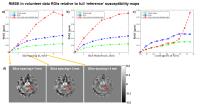 |
The Effect of Large Slice Thickness and Spacing and Low Coverage
on the Accuracy of Susceptibility Mapping 
Anita Karsa1, Emma Biondetti1, Shonit
Punwani2, and Karin Shmueli1
1Medical Physics and Biomedical Engineering,
University College London, London, United Kingdom, 2Centre
for Medical Imaging, University College London, London,
United Kingdom
Susceptibility Mapping has emerging clinical applications.
To reduce scan time, clinical images are often acquired with
large slice spacing/thickness and reduced coverage. The
effect of these factors on susceptibility maps has not been
investigated. Here, we develop a simple framework to explore
the effect of low-resolution and low-coverage in the slice
dimension on the accuracy of susceptibility maps. Our
experiments with digital phantoms and volunteer images have
shown that the error in the estimated susceptibility
increases substantially with increasing slice
spacing/thickness and decreasing coverage. These results
underscore the need for high-resolution, full-coverage
acquisitions for accurate susceptibility mapping.
|
|
1556.
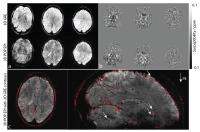 |
Accelerated Quantitative Susceptibility Mapping at 7T Using 3D
Planes-on-a-Paddlewheel (POP) EPI 
Daniel Stäb1,2, Steffen Bollmann1,
Christian Langkammer3, Kristian Bredies4,
and Markus Barth1
1The Centre for Advanced Imaging, The University
of Queensland, Brisbane, Australia, 2Department
of Diagnostic and Interventional Radiology, University of
Würzburg, Würzburg, Germany, 3Department
of Neurology, Medical University of Graz, Graz, Austria, 4Institute
for Mathematics and Scientific Computing, University of
Graz, Graz, Austria
Ultra-high field whole brain susceptibility mapping at an
isotropic resolution of 1 mm was performed within 16 seconds
using a 3D planes-on-a-paddlewheel (POP) EPI sequence. The
non-Cartesian readout scheme is created by rotating a
standard EPI readout train around its own phase encoding
axis and provides higher flexibility for echo time
minimization than conventional 3D EPI. Morphologic images
and susceptibility maps obtained were comparable to those
acquired with a conventional 4 minute 3D GRE scan.
|
|
1557.
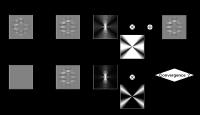 |
Quantitative Susceptibility Mapping Using Adaptive
Edge-Preserving Filtering: Comparison with COSMOS in Human Brain
Toru Shirai1, Ryota Sato1, Yo
Taniguchi1, Takenori Murase2, Atsushi
Kuratani2, Taisei Ueda2, Takashi
Tsuneki2, Yoshitaka Bito2, and Hisaaki
Ochi1
1Research and Development Group, Hitachi, Ltd.,
Tokyo, Japan, 2Healthcare
Campany, Hitachi, Ltd., Chiba, Japan
We have proposed that a QSM reconstruction method
combining an iterative least square minimization and
adaptive edge-preserving filtering could generate
high-quality susceptibility maps. In this study, maps
calculated by the proposed method were compared
qualitatively and quantitatively with those calculated by
COSMOS (a calculation of susceptibility through
multiple-orientation sampling) in healthy volunteers. The
results from human brain experiments showed good agreement
with COSMOS. The proposed QSM reconstruction of single
orientation sampling is useful for generating a high-quality
susceptibility map of the human brain.
|
|
1558.
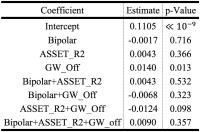 |
QSM at 3T: Comparison of Acquisition Methodologies 
M Louis Lauzon1,2,3, Cheryl Rae McCreary1,2,3,
D Adam McLean3,4, Marina Salluzzi3,4,
and Richard Frayne1,2,3
1Radiology and Clinical Neurosciences, University
of Calgary, Calgary, AB, Canada, 2Hotchkiss
Brain Institute, Calgary, AB, Canada, 3Seaman
Family MR Research Centre, Calgary, AB, Canada, 4Calgary
Image Processing and Analysis Centre, Calgary, AB, Canada
We scanned 4 volunteers 3 times each using 8 different QSM
variants (unipolar/bipolar readout gradient, accelerated or
not, with/without gradient warp-correction), and compared
the susceptibility (average and standard deviation) in five
deep gray matter tissues using linear mixed effects
modeling. Gradient-warp correction was found to decrease the
susceptibility estimates by 3-5%, whereas there was no
statistical difference in the estimates due to readout
polarity or acceleration factor.
|
|
1559.
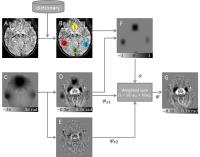 |
Adaptive background phase removal using knowledge-based region
detection for quantitative susceptibility mapping
Taichiro Shiodera1, Takamasa Sugiura1,
Yuko Hara1, Yasunori Taguchi1,
Tomoyuki Takeguchi1, Masao Yui2,
Naotaka Sakashita2, Yasutaka Fushimi3,
Takuya Hinoda3, Tomohisa Okada3, Aki
Kido3, and Kaori Togashi3
1Toshiba Corporation, Kawasaki, Japan, 2Toshiba
Medical Systems Corporation, Otawara, Japan, 3Kyoto
University Graduate School of Medicine, Kyoto, Japan
We propose a background phase removal method for
quantitative susceptibility mapping using adaptive kernels
depending on brain region. Conventional methods use distance
adaptive kernel spherical mean values (SMV) to estimate
background phase. However, artifacts occur where kernel
sizes are not optimal for certain brain regions. Here, we
adapt SMV kernel sizes depending on brain regions which are
automatically detected by machine learning methods. The
proposed method eliminates tissue phase artifacts near
air-tissue interfaces in more central areas such as the
sinus. The proposed method also eliminates streak artifacts
in susceptibility images.
|
|
1560.
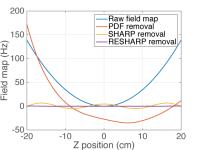 |
Effects of concomitant gradients on Quantitative Susceptibility
Mapping 
Timothy J Colgan1,2, Diego Hernando1,
Samir Sharma1, Debra E Horng1,2, and
Scott B Reeder1,2,3,4,5
1Radiology, University of Wisconsin, Madison, WI,
United States, 2Medical
Physics, University of Wisconsin, Madison, WI, United
States, 3Biomedical
Engineering, University of Wisconsin, Madison, WI, United
States,4Medicine, University of Wisconsin,
Madison, WI, United States, 5Emergency
Medicine, University of Wisconsin, Madison, WI, United
States
MR-based Quantitative Susceptibility Mapping (QSM)
techniques have multiple potential applications in brain and
body imaging. QSM techniques generally rely on the removal
of background field effects to obtain a local B0 map,
followed by dipole inversion to estimate the underlying
susceptibility distribution. However, concomitant gradients
introduce significant unanticipated phase shifts in the
acquired data that manifest as errors in the measured B0
field map. Our results demonstrate that CG phase corrections
and/or the use of a background field removal algorithm that
removes this background field component are necessary for
accurate QSM.
|
|
1561.
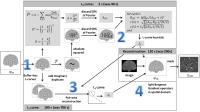 |
QSM: fast selection of optimal regularization weights
Job Gijsbertus Bouwman1 and
Peter R Seevinck1
1Image Sciences Institute, University Medical
Center Utrecht, Utrecht, Netherlands
Quantitative Susceptibility Mapping reconstructions may
benefit from L1-regularization and magnitude weighing,
however these iterative reconstruction methods are
time-consuming. Recently, progression has been made in
reducing the reconstruction times with Split Bregman
iterations, allowing subject-specific regularization
weights. Here a further reduction of the reconstruction time
is reported, mostly based on accelerating the automatic
selection of the optimal regularization parameter. The
overall procedure reduces computational load more than
threefold, without accuracy loss. Reduction of
reconstruction times, may contribute to realize QSM
algorithms which are either clinically feasible, or that may
pave the way to include more sophisticated regularization
mechanisms.
|
|



